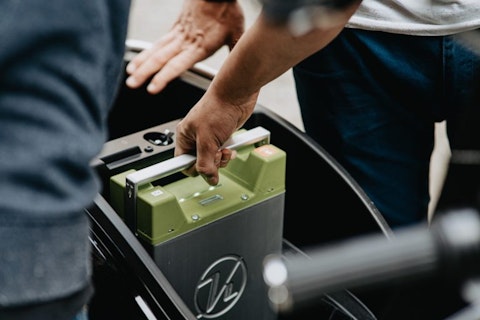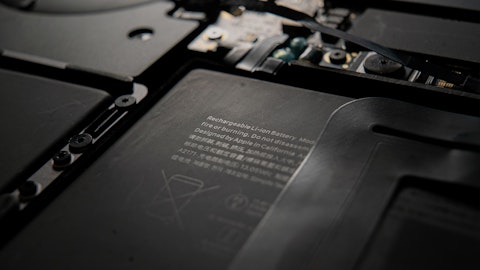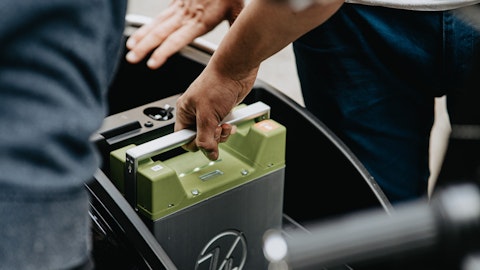We will take a look at the top 15 countries in the world based on lithium reserves. To skip our analysis of the recent market trends, you can go directly to see the Top 5 Countries by Lithium Reserves.
Lithium is a soft, silvery-white alkali metal found naturally across the world. The metal has multiple uses across the world, but the most common usage of this element is in batteries for storage of electricity. According to the U.S. Geological Survey, 80% of the lithium produced across the world is consumed for battery manufacturing while the rest is used in ceramics and glass, greases, medical, and other uses.
Three main types of Lithium resources are available that offer economical extraction. These include brines, spodumene, and lepidolite. Brine deposits, mainly found across Bolivia, Chile, Argentina, United States, and China, are saltwater accumulations that contain dissolved lithium. Spodumene and lepidolite are hard rock compounds of lithium with spodumene possessing a significantly higher lithium content. Some of the world’s largest hard rock lithium resources are located in Australia, China, and Canada, among others.
According to the U.S. Geological Survey, there are 98 million metric tons of lithium resources across the globe with the largest portion of these resources (53%) located in three South American countries, generally referred to as the “lithium triangle” – Bolivia, Chile, and Argentina. European countries hold nearly 7.4 million tons of these resources while Africa is home to nearly 5 million tons of lithium resources.
Identified resources of lithium are defined as “Resources for which location, grade, quality, and quantity are known or estimated from specific geologic evidence.” Reserves are a subset of the resources and make up the part of resources that have been evaluated and deemed commercially viable for extraction. If we look at proven reserves, there is a grand total of 26 million tons of lithium spread across the world.
Out of the 26 million tons of global lithium reserves as per the U.S. Geological Survey published in January 2023, Chile was home to the largest lithium reserves base with 9.3 million tons of proven lithium reserves. Australia was ranked #2 based on the lithium reserves with a reserve base of nearly 6.2 million tons. Argentina and China were next on the global lithium reserves rankings with 2.7 million and 2.0 million tons of lithium, respectively.
Countries in the continent of Europe also hold significant quantities of lithium resources but exploration and feasibility studies are still in relatively earlier stages due to which there aren’t many known reserves of lithium across the continent. Some of the countries in Europe that have proven lithium reserves include Portugal, Germany, Austria, Czechia, Finland, Serbia, and Spain.
We have covered the most advanced battery technologies that are going to power our future in an earlier article: 10 Most Advanced Battery Technologies That Will Power the Future
Market Trends
The demand for lithium has picked up in recent years as countries across the globe introduce measures to switch from fossil fuels to clean energy sources. An important step in this endeavor is the reduction of vehicles with internal combustion engines which has led to the sudden rise in demand for electric vehicles. This has led to a significant increase in global consumption which increased by more than 40% y-o-y to reach 134,000 tons in 2022.
The increase in demand pulled the production of lithium as well which increased more than 20% y-o-y to reach 130,000 tons in 2022, still lower than the annual demand for the metal. Spot prices for lithium carbonate in China surged last year as they reached nearly $67,000 per ton in November from $35,000 in January. The prices have since dropped marginally but there are still concerns that the production needs to significantly increase in the upcoming years to match the demand for lithium.
Some of the leading companies involved in the production of lithium include American Lithium Corporation (NASDAQ:AMLI), Rio Tinto Group (NYSE:RIO), Ganfeng Lithium Group Co., Ltd. (OTC:GNENY), Piedmont Lithium Inc (NASDAQ:PLL), and Albemarle Corp. (NYSE:ALB), among others.

Photo by Kumpan Electric on Unsplash
Methodology
We have used the data from U.S. Geological Survey to identify the amount of identified lithium resources that each country have. Based on the survey results published earlier this year, 24 countries with lithium resources were identified. These countries were then sorted based on the resource quantities and the top 15 countries were picked for our list.
(We have used the resource quantities instead of reserves figures for our article as there are large quantities of the metal that haven’t been explored and assessed for the economic viability of their extraction as well as other factors. Identified resources are the superset for reserves and are defined as: “Resources for which location, grade, quality, and quantity are known or estimated from specific geologic evidence.”)
Lithium reserves by country: Top 15 Countries
15. Republic of Mali
Lithium Resources as of 2022: 840,000 metric tons
Republic of Mali is a landlocked country in West Africa. The country has vast experience with mining as gold has been its top export for nearly 10 consecutive years. In addition, the country also boasts availability of other mineral resources such as manganese, iron, oil, lithium, and others.
Two major lithium projects are under the exploration and development phase in Mali. A joint venture between Chinese lithium company, Jiangxi Ganfeng Lithium Co. Ltd, and Australian Leo Lithium Ltd. (ASX:LLL) leads the way with the Goulamina Lithium Project in southern Mali. The company expects first production in late H1 2024.
UK-based Kodal Minerals Plc (LSE:KOD) is focused on the development of the other major lithium project in Mali in partnership with a mining subsidiary of Chinese conglomerate Fosun International Ltd. It is working on the development of the Bougouni Lithium Project also located in Southern Mali.
14. Republic of Peru
Lithium Resources as of 2022: 880,000 metric tons
Republic of Peru also lies in South America and borders with Brazil and Bolivia to the east, Ecuador and Columbia to the north and the Pacific Ocean to the west. The country is rich in natural resources including gold, copper, zinc, lead, and iron.
Canadian mining company, American Lithium Corporation (NASDAQ:AMLI) currently has a lithium exploration project in the Puno region of Peru which lies on the border with Bolivia. The Falchani Lithium project is in an advanced stage with the prefeasibility study (PFS) expected to be completed by the end of 2023 or early 2024.
13. Russian Federation
Lithium Resources as of 2022: 1,000,000 metric tons
Russian Federation or Russia is a transcontinental country spanning Northern Asia and Eastern Europe. The largest country in the world by area, Russia shares land borders with 14 countries. Russia is home to some of the largest natural reserves of natural resources in the world including natural gas, oil, and minerals.
Russia also has large lithium reserves, but the reserves haven’t been utilized to produce the mineral locally. In February this year, Polar Lithium, a joint venture between mining and metallurgy company MMC Norilsk Nickel, and Russian state corporation, Rosatom, announced that it had received the exclusive right to develop lithium mining project Kolmozerskoye, located in Murmansk Region of the country.
Earlier in February 2022, Russian gas company, Gazprom had announced the signing of documents for a lithium production project at its Kovyktinskoye gas field for production and processing of brines to obtain lithium compounds and other minerals.
12. Republic of Serbia
Lithium Resources as of 2022: 1,200,000 metric tons
Republic of Serbia is a landlocked country in the Southeastern and Central Europe. The country shares land borders with several countries including Hungary, Romania, Bulgaria, North Macedonia, and Croatia, among others.
Anglo-Australian mining company, Rio Tinto Group (NYSE:RIO) was working on a lithium mining project located near Loznica in the Jadar Valley in Western Serbia. The Serbian government revoked the licenses for the mining company in January 2022 after prolonged protests sparked by environmental concerns. The project valued at $2.4 billion, could have led to the production of nearly 58,000 tons of refined lithium.
11. Czechia
Lithium Resources as of 2022: 1,300,000 metric tons
Czechia, formerly known as the Czech Republic, is a landlocked country located in the Central Europe and bordered by Slovakia to the southeast, Poland to the northeast, Germany to the west, and Austria to the south.
Cinovec is a former tin mining village located 100 km from Prague on the border with Germany. The site hosts the largest lithium resource in Europe. Australian mining company, European Metals Holdings Ltd (OTC:EMHXY) formed a joint venture with CEZ a.s., a Czech energy company majority owned by the state. The project is currently in the Definitive Feasibility Study phase for the construction of a 29,386 tons per annum lithium hydroxide plant.
10. Mexico
Lithium Resources as of 2022: 1,700,000 metric tons
Mexico, officially the United Mexican States, has lithium resources estimated at 1.7 million metric tons. Despite that, there is currently no commercial mining exploitation of lithium in the country. There are several projects at the exploration phase in Jalisco, Guanajuato, Nogales, Sonora, and Puebla.
The most advanced lithium exploration project is the Sonora clay project which is beneficially owned by the Chinese mining and metals company, Ganfeng Lithium Group Co., Ltd. (OTC:GNENY). There are nearly a dozen foreign companies that have active mining concessions and are planning to develop lithium projects.
9. Canada
Lithium Resources as of 2022: 2,900,000 metric tons
Lithium Reserves as of 2022: 930,000 metric tons
Canada is the second-largest country in the world by land area with ten provinces and three territories extending from the Atlantic Ocean to the Pacific Ocean and into the Arctic Ocean. The country hosts large hard rock spodumene deposits and brine-based lithium resources.
The lithium mining industry in Canada has had its ups and downs during the recent past. The country had limited lithium production from 2014 to 2019 which was later suspended due to the significant drop in the lithium prices.
Currently, two mines are in the production stage: the Tanco Mine in Manitoba, which is owned by Chinese mining company, Sinomine Resource Group Co., Ltd., and the North American Lithium mine in Quebec which is owned by a joint venture between Sayona Mining Ltd. (OTC:SYAXF) and Piedmont Lithium Inc (NASDAQ:PLL).
8. Democratic Republic of Congo (DRC)
Lithium Resources as of 2022: 3,000,000 metric tons
The Democratic Republic of Congo, also known as Congo-Kinshasa and formerly known as Zaire, is a country located in Central Africa. It is the second largest country in Africa by land area and is extremely rich in natural resources. Congo is the largest producer of Cobalt as it accounts for more than 70% of the global production of the commodity.
Australian mining company, AVZ Minerals Ltd. (OTC:AZZVF) is the majority owner of the Manono Lithium project in Congo, which is touted to be one of the largest undeveloped hard rock lithium deposits in the world. There is a dispute about the ownership of a minority stake in the project filed by a Chinese mining company, Zijin Mining Group Co., Limited, and a state-owned entity in DRC.
7. Germany
Lithium Resources as of 2022: 3,200,000 metric tons
Germany, officially the Federal Republic of Germany, located in Central Europe, is the second most populous country in the continent. It shares borders with Denmark, Poland, Czech Republic, Austria, Switzerland, France, Luxembourg, Belgium, and the Netherlands.
The Zinnwald Lithium Project is located 35 kms from Dresden and is owned by Zinnwald Lithium PLC with the planned capacity to supply 12,000 tons of LiOH per annum. The other project is titled Zero Carbon Lithium and is owned by Australian company, Vulcan Energy Resources Ltd. (ASX:VUL). The company aims to produce 24,000 tons per annum of lithium hydroxide monohydrate.
6. China
Lithium Resources as of 2022: 6,800,000 metric tons
Lithium Reserves as of 2022: 2,000,000 metric tons
China, officially the People’s Republic of China, is a country in East Asia with a population that exceeds 1.4 billion people. The country is rich in natural resources such as coal, and iron ore, among others. It also has significant lithium resources at nearly 6.8 million metric tons which accounts for more than 14% of the global resources.
China is the third-largest producer of lithium in the world with more than 19,000 metric tons of lithium in 2022, accounting for more than 14% of the global production. Major Chinese companies involved in the mining and refining of lithium include Ganfeng Lithium Co., Ltd. (OTC:GNENY), Tianqi Lithium Corp (HKEX:9696), and EVE Energy Co., Ltd., among others.
Click to continue reading and see Lithium Reserves by Country: Top 5 Countries
Suggested Articles:
- 16 Best Retirement Communities in Florida Near the Beach
- 20 American Cities With the Highest Uninsured Rates
- 20 Poorest Countries in Europe
Disclosure: None. Lithium Reserves by Country: Top 15 Countries is originally published on Insider Monkey.





